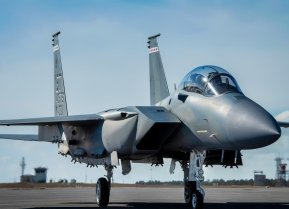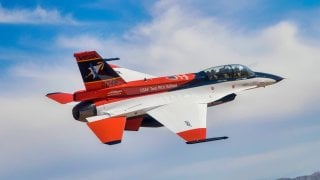X-62A VISTA Is a Very Special F-16 Fighting Falcon Thanks to AI
U.S. Secretary of the Air Force Frank Kendall recently experienced a flight in the X-62A VISTA at Edwards Air Force Base, showcasing significant progress in autonomous aircraft technology. The X-62A, a modified F-16 Fighting Falcon, incorporates AI and machine learning from DARPA's Air Combat Evolution (ACE) program.
Summary: U.S. Secretary of the Air Force Frank Kendall recently experienced a flight in the X-62A VISTA at Edwards Air Force Base, showcasing significant progress in autonomous aircraft technology. The X-62A, a modified F-16 Fighting Falcon, incorporates AI and machine learning from DARPA's Air Combat Evolution (ACE) program. During the flight, the aircraft autonomously executed tactical maneuvers without human intervention, although a pilot was present as a safety measure.
-This test highlights advances in military aviation similar to the development of stealth technology, moving toward an AI-enabled fleet that supports more complex, autonomous operations.
-This technology could significantly impact the Air Force's Next Generation Air Dominance program by integrating manned fighters with autonomous support platforms, optimizing decision-making in combat scenarios.
X-62A VISTA: Bridging the Gap Between Man and Machine in the Skies
U.S. Secretary of the Air Force Frank Kendall has logged more than his fair share of miles in the air. But even as the top civilian official for the service, he rarely gets in the cockpit of a fighter plane – and never for a flight like the one he took last week. Kendall was treated to the experience of a lifetime as he flew in the front seat of the X-62A VISTA at Edwards Air Force Base, California.
The test flight allowed Kendall to see for himself the progress the Air Force is making toward developing an autonomous aircraft. According to the Air Force, the VISTA incorporates artificial intelligence and machine learning. The technology was developed in collaboration with DARPA's Air Combat Evolution (ACE) program.
"The potential for autonomous air-to-air combat has been imaginable for decades, but the reality has remained a distant dream up until now,” Kendall said in a statement. “In 2023, the X-62A broke one of the most significant barriers in combat aviation. This is a transformational moment, all made possible by breakthrough accomplishments of the ACE team.”
The aircraft was autonomously flown during Kendall's flight, and the X-62A even conducted a variety of tactical maneuvers that included responding to a simulated threat. While a human pilot was still in the rear seat and ready to take over if necessary, no one touched the controls during the flight, the Air Force announced.
A Very Special F-16
The X-62A VISTA – Variable In-flight Simulation Test Aircraft – is a heavily modified F-16 Fighting Falcon adorned with orange and white paint that makes it quite hard to miss in the sky.
As noted by The Associated Press, the use of artificial intelligence in military aircraft marks one of the biggest advances in military aviation since the introduction of stealth in the early 1990s. The technology remains very much in the developmental stage – much like self-driving cars – but the U.S. Air Force has big plans and has called for an AI-enabled fleet of more than 1,000 unmanned aircraft.
Kendall's flight took place just weeks after the air service announced that an autonomously piloted F-16 Fighting Falcon had taken part in a series of simulated dogfights with a manned fighter.
As previously reported by Alex Hollings, the tests demonstrated significant advancements in the AI's ability to handle complex aerial maneuvers and dogfights.
ACE could contribute greatly to the Air Force's Next Generation Air Dominance program, which seeks to develop a "system of systems" including a manned sixth-generation fighter supported by autonomous platforms. The fighter pilot would still make the big decisions, such as developing an overall engagement strategy, selecting and prioritizing targets, and determining the best weapon or effect. Lower-level functions, such as the details of aircraft maneuver and engagement tactics, could be left to the autonomous systems.
"AI is really taking the most capable technology you have, putting it together, and using it on problems that previously had to be solved through human decision-making," Kendall added. "It's automation of those decisions and it's very specific."
Author Experience and Expertise: Peter Suciu
Peter Suciu is a Michigan-based writer. He has contributed to more than four dozen magazines, newspapers, and websites with over 3,200 published pieces over a twenty-year career in journalism. He regularly writes about military hardware, firearms history, cybersecurity, politics, and international affairs. Peter is also a Contributing Writer for Forbes and Clearance Jobs. You can follow him on Twitter: @PeterSuciu. You can email the author: [email protected].


